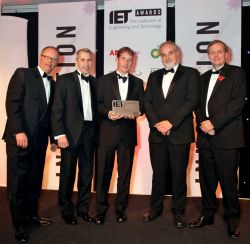Sensor wins engineering innovation award
An innovative sensor developed at Sussex has won a major engineering award.
 (L-R) Host Robert Llewellyn, presenter of TV's 'Scrapheap Challenge'; Keith Strickland, Plessey's Technical Director; Paul James, Plessey's Commercial Director; Professor Robert Prance, who led the Sussex team; and Dr Robin Hart, who sponsored the award.
(L-R) Host Robert Llewellyn, presenter of TV's 'Scrapheap Challenge'; Keith Strickland, Plessey's Technical Director; Paul James, Plessey's Commercial Director; Professor Robert Prance, who led the Sussex team; and Dr Robin Hart, who sponsored the award.
The Electrical Potential Sensor (EPS), a non-contact voltmeter that is capable of acquiring electrical signals remotely, was triumphant in the ‘Measurement in Action’ category of the Institution of Engineering and Technology (IET) Innovation Awards.
The award is for the best innovation this year in the field of measurement science and technology.
The EPS technology has a wide range of interdisciplinary applications, from being able to monitor a patient’s heart rate remotely through a handheld sensor, to measuring the electrical imprint of fingerprints.
It has been developed by a team based in the Department of Engineering and Design, led by Professor Robert Prance, and is being licensed and manufactured as the Electric Potential IC (EPIC) sensor by Plessey Semiconductors Ltd.
The IET, one of the world’s leading professional societies for engineering and technology, presented 15 awards in total at a gala ceremony and dinner in London on Wednesday 9 November.
Professor Mike Short, President of the IET, commented: “These awards are a great way to showcase some fantastic innovations taking place in engineering and technology worldwide. The winners this year come from a wide variety of backgrounds and many have aimed to solve issues that impact our society.”
The EPS was also shortlisted in two other categories: ‘Electronics’ and ‘Emerging Technologies’.
Professor Bob Allison, Pro-Vice-Chancellor (Research), said: “We are delighted that the EPS continues to be recognised as a major achievement.
“This technology could impact widely on quality of life, safety and security, wealth generation and new research tools by providing: affordable healthcare solutions for the ageing population; passive sensors for the security and safety markets; and a new generation of test and measurement equipment for physical, biological and medical research and for the semiconductor and materials manufacturing sectors.”
It capped a successful seven days for the sensor, which, on 3 November, received the R&D Achievement Award from the NMI, the UK trade association for semiconductor, microelectronics and electronic systems. The judges praised the “exemplary collaboration” between Plessey and Sussex and recognised that the new technology “opens up a huge range of possible applications and new markets”.
